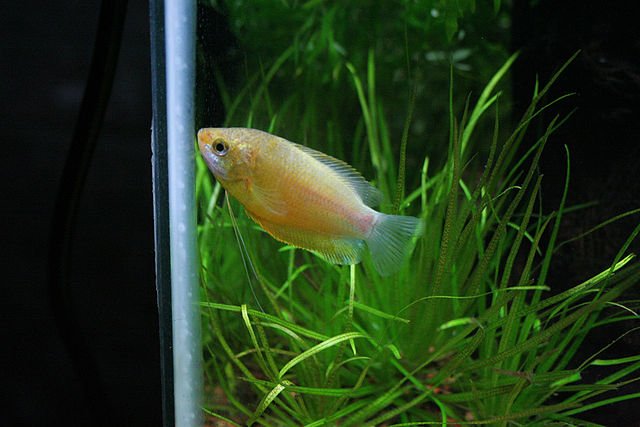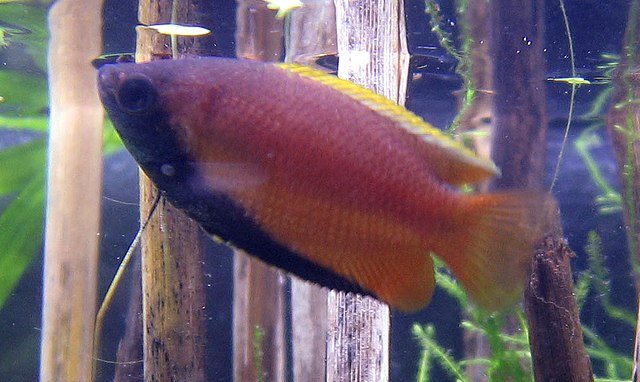
The honey gourami is a highly popular fish due to its peaceful nature, attractive coloration, and hardiness, making it an ideal choice for beginner enthusiasts of community aquariums.
Originating from Asia, the honey gourami is relatively easy to breed and can be accomplished by aquarists of all experience levels worldwide. Because of its size, these fish can be raised in small aquariums.
Beyond its commercial significance in the ornamental fish industry, in certain regions of India, gourami fish are a part of the local population’s diet due to their fast growth and nutritional profile.
This article aims to provide you with a series of tips for the care, feeding, and reproduction of your honey gourami fish. The information will assist you in enhancing the well-being of your ornamental fish as you keep them in fish tanks.
Taxonomy and Characteristics of the Honey Gourami
Phylum: Chordata
Class: Actinopterygii
Order: Anabantiformes
Family: Osphronemidae
Genus: Trichogaster
Scientific Name: Trichogaster chuna
Synonyms: Colisa chuna, Trichopodus chuna, Trichopodus sota, Colisa sota
Common Names: “Honey Gourami,” “Sunset Gouramis,” “Red Honey Gourami,” “Honey Dwarf Gourami,” “Red Flame Gourami,” and “Dwarf Fire Gourami.”
Honey gourami fish (Trichogaster chuna) stand out for their vibrant colors and elegant appearance. Their body is flat and oblong with two modified ventral fins; they can reach a total length of 5.5 cm in females and 4 cm in males, although honey gouramis of up to 7 cm in length have been reported.
Honey gouramis can live between 5 and 8 years, depending on the care you provide for these beautiful fish.
Male honey gouramis exhibit more vibrant hues, with tones of golden yellow and red, and a region of dark blue or black (Frankel, 2008); whereas female honey gouramis display a pale golden coloration. Their fins are long and flowing, adding to their overall elegance.

An important feature of gouramis in general is that they possess a labyrinth organ to directly extract oxygen from the air, making them resistant to low oxygen levels in water that often occur due to neglect in fish tanks.
Honey gouramis are frequently mistaken for dwarf gouramis (Trichogaster lalia). In another article, we will provide you with more technical information about caring for dwarf gouramis.
Habitat and Natural Distribution of the Honey Gourami
The honey gourami originates from South Asia, specifically from the northeastern region of India in the Ganges basin. Wild populations have been reported in the Jamuna basin of Bangladesh, and some natural populations exist in Nepal as well.
This charming fish species thrives in calm and slow-moving waters, such as ponds, lakes, and swamps. Its natural habitat is characterized by dense vegetation, providing the perfect sanctuary for honey gourami fish to thrive. The warm and tropical climate of South Asia creates an ideal environment for this remarkable species to flourish and develop its distinct flavors.
Care for Honey Gourami Fish
Having a honey gourami (Trichogaster chuna) as a pet can be a rewarding experience for both novice fish enthusiasts and experienced ones. Their dazzling appearance and unique behaviors make them a captivating addition to any community aquarium. Beyond their aesthetic appeal, this variety of gourami fish offers numerous benefits as a pet.
One key benefit is their ability to adapt to a wide range of water conditions, as they can directly extract oxygen from the air when aquarium conditions are poor. The honey gourami (Trichogaster chuna) prefers the bottom areas of the aquarium and spends less time in the surface area (Palva, 2022). The honey gourami is a resilient fish species that can tolerate variations in water parameters, making it easier to maintain a stable and healthy environment.
Table 01. Technical Parameters for Caring for Honey Gourami Fish (Trichogaster chuna).
| Parameter | Range |
| Tank Size | Minimum 10 liters per fish |
| Water temperature | 24 – 28 oC |
| pH | 6,0 y 8,0 |
| Water Hardness | 4 – 15 dGH |
| Nitrate | < 50 mg/L |
| Lighting | Moderate |
| Water Change (monthly) | 20 to 30% of water volume |
What does the Honey Gourami (Trichogaster chuna) eat?
The Honey Gourami is an omnivorous fish with a varied diet. In its natural habitat, it feeds on a combination of plant matter, insects, small crustaceans, and zooplankton. To replicate its natural diet in an aquarium setting, it’s important to provide a diverse and balanced diet that meets its nutritional needs.
Honey Gourami fish thrive on live and frozen foods such as brine shrimp, bloodworms, daphnia, and mosquito larvae. These foods provide additional enrichment and mimic their natural feeding behavior.
Swain et al., (2021) recommend conditioning Honey Gourami breeders with a mixture of live zooplankton and tubifex, along with floating pellets, three times a day.
Various researchers recommend feeding Honey Gourami larvae with infusoria for the first 10 days, Artemia after 10 days, and balanced food three weeks after hatching.
Mithun et al., (2019) highlight that diets for T. chuna with 30% protein and 6% lipids are suitable for normal growth, while feeds with 40% protein and 6% lipids help accelerate growth and reproduction. Furthermore, gourami diets should contain carotenoids (astaxanthin, zeaxanthin, or lutein) to enhance coloration (Jena et al., 2019).
In this regard, 梁峻嘉 (2017) recommends adding 75 mg/kg of zeaxanthin, 75 mg/kg of free-form astaxanthin, or 50 mg/kg of ester-type astaxanthin to Honey Gourami diets (Trichogaster chuna) to maintain good coloration.
How do Honey Gourami fish reproduce?
When it comes to breeding Honey Gourami fish, the first thing to do is ensure you have at least one male and one female. The male Honey Gourami typically has more vibrant coloration than the female, and its belly takes on a dark blue to black color during courtship.

It has been reported that honey gouramis reach sexual maturity between 4 to 6 months; however, it is recommended to have breeders that are at least 1 year old. Under appropriate temperature conditions, these fish can reproduce year-round.
It’s important for the breeding aquarium to have abundant floating vegetation so that male honey gouramis can construct bubble nests. In the tank, there should only be one male and one female, and you should feed them well to stimulate reproduction and subsequent spawning.
Swain et al., (2021) studied the influence of substrate for bubble nest construction by male honey gouramis and obtained the best results with Bermuda grass (Cynodon dactylon), followed by hydrilla (Hydrilla verticillata) and banana leaves.
Honey gourami fish exhibit unique courtship rituals, with the male building bubble nests on the water’s surface. The female will then lay between 500 to 3000 eggs, and the male will care for the nest until the fry hatch. It’s important to remove the female after spawning to prevent aggression from the male.
The eggs hatch after 24 to 36 hours, and honey gourami fry can swim freely after another 1 to 2 days.
Fish Compatible with Honey Gourami Fish
Honey gourami fish possess a variety of unique characteristics and behaviors that make them a fascinating addition to any aquarium. Moreover, their peaceful nature makes them compatible with a variety of tankmates, allowing for a diverse and visually appealing community tank.
Neon tetras, rasboras, Corydoras catfish, Rosy loaches, guppies, mollies, danios, or cherry shrimp are good choices to keep together with honey gouramis. Breeding them with betta fish is not recommended.
Providing ample space and hiding spots is important for honey gouramis to reduce stress and promote a harmonious environment. They are generally not aggressive, but territorial disputes can arise if space is limited.
Adding floating plants or creating dense vegetation in the aquarium will mimic their natural habitat and ensure they feel secure.
Diseases
Honey gourami fish can be prone to bacterial, fungal, and parasitic infections. Maintaining good water quality, providing a balanced diet, and quarantining new fish before introducing them to the main tank can help prevent disease spread.
Labyrinth Organ Issues
The labyrinth organ of the honey gourami is susceptible to damage if the water surface is not accessible for them to breathe air. Ensure there is enough surface area for them to gulp air, especially if you have densely planted tanks.
Fin Rot
Fin rot in honey gouramis is a bacterial infection and is a common issue when tank water quality is poor. This infection can be prevented with regular water changes.
Conclusion
The vibrant colors, unique behaviors, and adaptability of honey gourami fish as pets make them a favorite among fish enthusiasts worldwide. In this regard, the information presented in this article can help you design your aquarium.
By understanding their origins, distinctive characteristics, care requirements, and breeding considerations, you can embark on the task of caring for honey gourami fish.
On the other hand, if you’re a fish farmer, honey gourami fish production can be a good option due to the demand for this species in the global ornamental industry.
Bibliographical References
Aquarium Coop. Care Guide for Honey Gouramis – Our Favorite Peaceful Gourami
Frankel, J. S. (2008). Monogenic control of sex-limited colouration in the honey gourami, Trichogaster chuna. Journal of genetics, 87(3), 271.
Jena, A. K., Biswas, P., & Pattanaik, S. S. (2019). Recent trends in breeding and trade of ornamental gourami in India. World Aquaculture, 61.
Mithun, S, Vijayagopal, P, Chakraborty, K, Chan, DPS. Evaluation of gross protein and lipid requirements in formulated feed for honey gourami, Trichogaster chuna (Hamilton 1822). J World Aquacult Soc. 2019; 50: 800–814. https://doi.org/10.1111/jwas.12557
Palva-Aho, Tuu. 2022. Depth preference in teleost fish: an interspecies study. Padua Thesis and Dissertation Archive
Sheppard Millie. 2022. Honey Gourami (aka Sunset): Care, Size & Tank Mates! Aquarium Source
Swain, S. K., Ail, S. K. S., Jena, S. K., Bairwa, M. K., & Sahoo, S. N. (2021). Preference of breeding substratum, embryonic development and seed production of honey gourami, Trichogaster chuna (Hamilton, 1822)-An indigenous ornamental fish in demand. Aquaculture, 542, 736874.
梁峻嘉. (2017). 飼料中添加不同類胡蘿蔔素對橙色恆河毛足鱸增豔效果之影響. Effects of dietary different carotenoids supplements on pigmentation of orange Honey gourami (Trichogaster chuna)
Editor at the digital magazine AquaHoy. He holds a degree in Aquaculture Biology from the National University of Santa (UNS) and a Master’s degree in Science and Innovation Management from the Polytechnic University of Valencia, with postgraduate diplomas in Business Innovation and Innovation Management. He possesses extensive experience in the aquaculture and fisheries sector, having led the Fisheries Innovation Unit of the National Program for Innovation in Fisheries and Aquaculture (PNIPA). He has served as a senior consultant in technology watch, an innovation project formulator and advisor, and a lecturer at UNS. He is a member of the Peruvian College of Biologists and was recognized by the World Aquaculture Society (WAS) in 2016 for his contribution to aquaculture.
